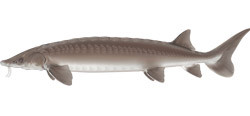
The Fish Sustainability Index (FSI) combines scientific and local knowledge to assess the health of Lake Sturgeon in Alberta.
Lake Sturgeon FSI Maps
Adult Density (Current and Historic)
- Current Adult Density Fish Sustainability (FSI) Rankings for Lake Sturgeon
- Historic Adult Density Fish Sustainability (FSI) Rankings for Lake Sturgeon
Stocked lake populations are denoted with a circle. Please note that data reliability is not currently displayed in these figures.
Habitat and Overharvest Protection Needs
- Habitat Protection Needs Fish Sustainability (FSI) Rankings for Lake Sturgeon, 2013
- Overharvest Protection Needs Fish Sustainability (FSI) Rankings for Lake Sturgeon, 2013
Please note that data reliability is not currently displayed in these figures.
The complete FSI spatial data layers can be viewed and downloaded in:
Please note that the Lake Sturgeon FSI assessment will be displayed in FWMIT at a watershed-scale, but Lake Sturgeon are primarily a mainstem river species.
Lake Sturgeon Population Status
Lake Sturgeon in Alberta are ranked as Threatened under the provincial Wildlife Act, and as Endangered by the national Committee on the Status of Endangered Wildlife in Canada (COSEWIC 2006). The 2013 Alberta Fish Sustainability Index (FSI) assessment confirmed these conservation designations. In summary, Lake Sturgeon are increasing from the critically low population levels of the past century, but are still in low numbers with few older adults. Healthy rivers and careful angling practices will continue to be necessary to maintain their recovery.
To maintain and enhance their recovery, Lake Sturgeon will require healthy rivers with natural flows and good water quality. Managing the potential effects of overfishing will continue to rely on Alberta anglers for monitoring data and their cautious use of catch-and-release fishing practices.
Historically, Lake Sturgeon were believed to be abundant in the South Saskatchewan River, Oldman River downstream of Fort Macleod, Bow River downstream of Bassano, Red Deer River downstream of Innisfail, and North Saskatchewan River downstream of Drayton Valley. In these river reaches, large fish (>1 m in length) may have been common.
Currently, numbers of large, adult Lake Sturgeon are very low in the North Saskatchewan River, but younger fish are more common and increasing.
The population in the South Saskatchewan River system is in somewhat better condition (particularly in the mainstem South Saskatchewan River), but numbers and distribution of both adults and young sturgeon are well below desired levels and sustainability remains at risk.
Threats to Recovery
The main threats to recovery of Lake Sturgeon were noted as:
- Overfishing and poor river water quality in the past century are believed to have caused severe declines, nearly eliminating the North Saskatchewan River sturgeon. Better sewage treatment by towns and cities, and catch-and-release angling have been key to bringing this species back from the brink.
- Dams on the Saskatchewan River system and long-term population declines have effectively isolated the two Alberta populations, adding to the difficulty of recovery and their conservation risk.
- Lake Sturgeon are very long-lived (perhaps over 100 years) and consequently can be easily overfished.
Next Steps
- Monitoring the recovery of Lake Sturgeon has relied extensively on Alberta sport fishermen providing data from careful catch-and-release angling. Since 1990, Fish and Wildlife staff and volunteer anglers have been effectively and consistently monitoring the North Saskatchewan River sturgeon population. Studies involving anglers have been ongoing on the South Saskatchewan River since 1968. These studies will continue to serve as excellent examples of biologists and anglers working together to conserve Alberta's fishes.
- Although great improvements have been made to Alberta's river water quality, increasing urbanization, agricultural, and industrial development must be carefully managed to avoid the mistakes of the past. Dams and changes to flows in rivers can further isolate and threaten the sustainability of Alberta's Lake Sturgeon. Careful land use planning and management is necessary, and Lake Sturgeon are now a key component of both the South Saskatchewan and North Saskatchewan Land-use Frameworks.